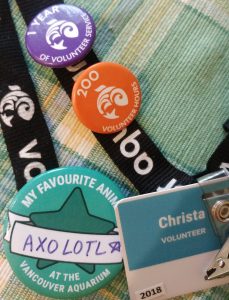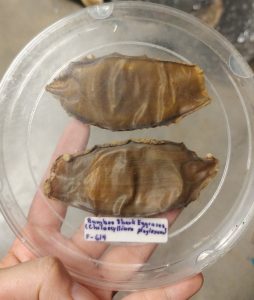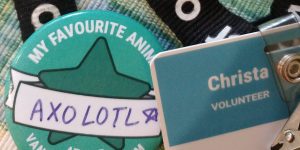 I have been a volunteer at the Vancouver Aquarium for 2 years now and during this time I've gone from being completely clueless as to what "baleen" is to now sharing all my favourite cartilaginous fish facts with everyone I meet!
I have been a volunteer at the Vancouver Aquarium for 2 years now and during this time I've gone from being completely clueless as to what "baleen" is to now sharing all my favourite cartilaginous fish facts with everyone I meet!
I first started as a Marine Educator, teaching elementary and high school students in a closed classroom with hands-on interactions with invertebrates, dissections, and group discussions to draw connections to their curriculum. Nowadays, I volunteer as a Gallery Educator on the weekends, engaging visitors of all ages in the galleries with props like sea otter fur, urchin skeletons (called tests), and jars of great Pacific octopus eggs.
I love both roles, and volunteering at the aquarium has taught me how to speak with confidence and experiment with teaching methods such as visual and sensory props and active play for children.
Shark egg cases are one of my favourite props to show visitors, and here's how a typical interaction would go:

Hook - questions and fast facts to reel in your audience
- Have you ever seen a mermaid's purse before?
- Sharks have no bones! They only have cartilage which is the same stuff in human noses and ears.
- Why might an animal lay eggs versus have live young?
Talking points
- Some sharks are oviparous, meaning they lay eggs just like this! They are informally known as "mermaids purses" or "devil's wheelbarrows", are made of collagen, and can usually be found attached to kelp.
- Most species of larger sharks like great whites are viviparous, meaning they have live young. Some sharks are ovoviviparous which means (can you guess? ) they have eggs hence "ovo", but the eggs are hatched inside the mother, hence "vivi".
- Sharks have some of the longest gestation periods ever! A female spiny dogfish can be pregnant for as long as 22 months.
Conservation message
- There are sharks all over the world and at least 12 species live in BC, however, due to unsustainable fishing practices and ocean pollution, many species are on a decline and endangered. Certain species of shark are caught for their fins or entangled in fishing nets.
Call to Action
- One way to ensure that you are purchasing sustainably caught seafood is to look for the Ocean Wise symbol in your grocery store. The Vancouver Aquarium Ocean Wise program only labels seafood that is harvested in ways to reduce bycatch and reduce harm to marine habitats.
Here are some Major Skills I develop:
As a Marine Educator for the Wet Lab
- Educating groups of 10-30 elementary and high school students on marine life of the BC Coast and the conservation issues that affect them in order to inspire care for our environment and community
- Curating unique hands-on tours that respond to each student groups’ curiosities and school curriculum knowledge to improve their engagement and learning experiences
- Collaborating with a team of culturally diverse and multigenerational volunteers to share peer feedback on tour content and teaching methods
As a Gallery Educator
- Educating over 100 visitors a day with marine animal props to enhance their experience and connect them to the Aquarium's sustainability initiatives.
